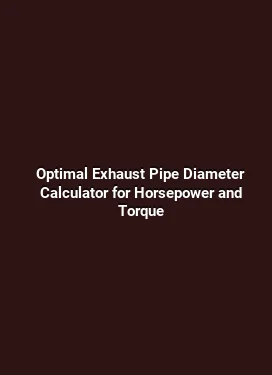How to Fix Exhaust Drone on Highway: Resonator Installation Guide
Exhaust drone on long highway drives can turn a pleasant ride into a tedious experience. A resonator installation offers a practical path to reducing high-frequency exhaust tones without a full exhaust rework. This guide provides a thorough, reader-focused approach to understanding what causes exhaust drone, how resonators work, and how to install and tune one for a smoother highway cruise. By combining hands-on steps with real-world testing, readers gain actionable knowledge that goes beyond surface explanations.
Understanding Exhaust Drone and Resonator Systems

Exhaust drone is the persistent vibration or tone that passengers hear at steady high speeds, typically around a specific RPM range. It arises from resonant frequencies produced by the exhaust system and the vehicle’s piping geometry. The goal of a resonator is to disrupt or absorb those specific frequencies, reducing the audible peak without compromising flow or engine performance. A properly chosen resonator can dampen drone while preserving a balanced exhaust note that still feels intentional and confident on the road.
Resonators differ from mufflers in their approach to sound. While mufflers focus on broad attenuation of sound waves, resonators target select frequencies, acting like a tuned filter. When selecting a resonator for highway drone, the key considerations include diameter compatibility with the existing piping, internal baffling or packing, and the resonator’s volume and length. A correctly matched part minimizes backpressure changes and maintains engine response while delivering a quieter, more comfortable ride. This section delves into the physics in practical terms, translating theory into concrete choices for DIY installers and professional shops alike.
Before You Start: Tools, Safety, and Planning
Preparation reduces mistakes and ensures a smoother installation. Start with a clear plan that accounts for your vehicle’s exhaust layout, mounting points, and nearby heat-sensitive components. A typical resonator installation requires basic hand tools, a cutting tool suitable for exhaust steel, clamps, welding or high-temperature resistant sealant, and a means to test fit before final assembly. Safety should be the top priority: work with the exhaust cold, use proper eye protection, and ensure the vehicle is securely lifted or supported when access is needed under the chassis.
Creating a short checklist helps keep the project organized. Confirm the target resonance frequency range you want to suppress, measure the available space for the resonator length, and verify that the chosen part’s diameter matches the exhaust pipe. Consider potential clearance issues with suspension components, brake lines, and heat shields. Planning also covers whether the resonator will be a direct replacement for an existing segment or added inline to an existing exhaust path. The outcome should be a coherent, balanced sound that reduces drone without producing an overly muted or artificial tone.
Choosing the Right Resonator for Highway Drone Reduction
Resonators come in various configurations, including chambered designs and absorptive models. Selection hinges on how aggressive the drone is and the sound you want to achieve. A compact resonator with a targeted frequency attenuation can be ideal for a precise drone at a specific RPM. For vehicles that experience drone across a broader range, a larger resonator with a broader attenuation curve may be more effective. It is essential to ensure compatibility with the vehicle's exhaust diameter, mounting style, and heat tolerance. A mismatch in diameter or mounting can lead to leaks, rattles, or unintended vibration that undermines the goal of a quieter ride.
Understanding the nuance between chambered versus absorptive resonators helps tailor performance. Chambered resonators trap sound waves within a parallel-wall structure, which can provide a more restrained tone. Absorptive resonators use materials that absorb sound energy, typically delivering deeper attenuation across frequencies. In many highway drone scenarios, a mid-range chambered design offers a practical balance between acoustic impact and breathability for exhaust flow. This section translates those concepts into practical selection steps, including how to read product specifications, what to ask suppliers, and how to evaluate compatibility with existing mounting points and hangers.
installation Steps: From Preparation to Seal
Installation proceeds through a series of precise steps that minimize leaks and ensure durability. The following sequence breaks down the process into executable stages, each with practical tips to avoid common pitfalls. Proper alignment and secure mounting are essential for long-term reliability, especially on highway trips where vibration and heat cycles are pronounced.
Preparing the System

Begin by inspecting the current exhaust path for any wear, corrosion, or loose hangers. Mark the section where the resonator will be integrated and ensure there is a clean, accessible joint surface. If you are replacing an existing section, measure the length and diameter to confirm the new resonator will fit without forcing bends or creating clearance issues. A dry fit, using clamps rather than welding initially, helps detect potential alignment problems before permanent work begins. A successful dry fit should show no contact with the floor, suspension, or heat shields and should align with the vehicle’s underside profile to minimize drag or noise sources beyond the drone.
Gather essential tools for the job: belt or fuel-line clamps, ear protection, a cutoff tool suitable for steel tubing, a grinder with a flap disc for edge finishing, a metal file for precise edge work, high-temperature exhaust sealant, and, if welding, a reputable MIG welder with appropriate shielding gas. Safety awareness is crucial due to hot surfaces and fumes generated during welding, so perform all steps with the engine cool and in a well-ventilated area. Keeping a clean workspace reduces the risk of foreign debris entering exhaust passages during assembly.
Mounting the Resonator
The core of the installation is aligning the resonator with the existing exhaust path. Start by sliding the resonator into place without fully tightening any clamps to check fitment. Make sure the inlet and outlet orientations are correct and that the mounting tabs align with the factory hangers or any upgraded brackets you plan to use. If the resonator uses a flanged connection, ensure that the flange surface is clean and that a gasket, if required, is present and seated correctly. For slip-fit designs, use appropriate clamps that distribute clamping force evenly to avoid crushing the pipe ends and creating a restrictive point in the flow path. A well-mounted resonator should sit parallel to the vehicle’s underbody without bending the exhaust pipe or stressing the flange joints.
Fastening techniques matter for vibration control. Tighten clamps in a sequence that evenly distributes load, and avoid overtightening, which can distort pipe ends or warp flanges. If welding is chosen, ensure a clean weld bead with proper penetration. After mounting, perform a gentle manual check for wobble or movement through the joint. A solid connection with equalized pressure around the joint helps prevent leaks and minimizes the risk of a rattling sound as the vehicle experiences road vibration.
Sealing and Leak Check
Leak testing is a critical step that directly affects perceived drone reduction. Start the engine at idle and listen for any hissing or whistling sounds around the joints. If a leak is detected, tighten clamps gradually or reapply sealant in the affected area. For welded joints, inspect for any gaps or porosity; re-weld if necessary to ensure a uniform seal. A smoke test or soapy water spray at the joints can reveal small leaks that are not audible at idle but become noticeable at higher RPMs. After confirming a leak-free assembly, re-check clearance around nearby components and re-torque clamps after the system settles with heat cycling. The end result should be a stable, drone-free experience without introducing new resonance elsewhere in the exhaust path.
Road Testing: Tuning and Verifying on the Highway
Actual road testing is the definitive step to validate the installation. Start with a controlled highway run at a steady speed that previously produced drone. Bring a notebook or a simple audio recording device to compare cabin noise before and after the resonator addition. Listen for changes in tone, strength of the drone, and any new rattles or vibrations that may indicate a mounting issue. A well-executed test should reveal a noticeable reduction in high-frequency drone, while the exhaust tone remains natural and consistent with the vehicle’s character. If the drone remains at certain RPMs, consider minor adjustments such as relocating a mounting point or adding a slight angle change to the resonator to alter the bore interaction and impedance characteristics.
Practical tuning strategies include using a test route with repeated segments at the target speeds, validating data with multiple drivers to account for cabin acoustics. When evaluating results, focus on the absence of persistent drone rather than a mere change in tone. If needed, a secondary smaller resonator can be added as a stage-two improvement, or a different internal design can be selected to broaden attenuation across a wider RPM range. Remember that the aim is a harmonious sound profile that feels natural and composed during cruise rather than an overly muffled or engineered tone that sounds artificial in the cabin.
Maintenance and Longevity: Keeping the System Sounding Right
Maintenance is often overlooked yet essential to long-term satisfaction. Periodic inspections should include checking mounting hardware for loosening due to vibration, inspecting for exhaust leaks around joints, and listening for changes in tone that could indicate heat-induced damage or corrosion. Heat shields and surrounding components should be checked to ensure they remain properly positioned and free of rattles. In regions with harsh winters or road salts, corrosion prevention becomes more critical, prompting more frequent checks and, if needed, protective coatings on bare metal surfaces near the resonator and mounting points.
Seasonal maintenance routines can be integrated into regular vehicle care. Include a quick inspection during tire rotations or oil changes to minimize extra downtime. If a resonator shows signs of internal packing degradation or a visible loss of attenuation, plan a replacement or upgrade to maintain acoustic performance. This approach ensures that the highway cruising experience remains comfortable and enjoyable over the life of the exhaust system, with consistent drone suppression and a balanced exhaust note that complements the vehicle’s overall performance profile.






